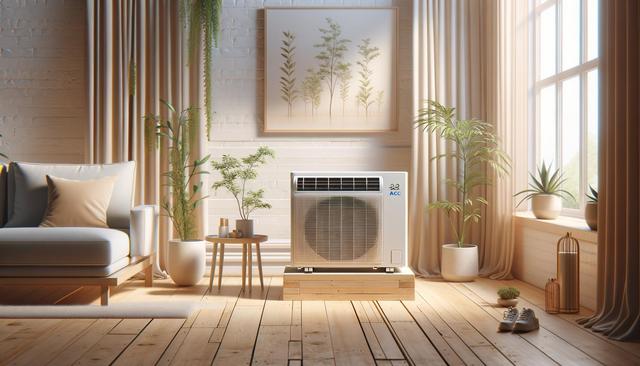What Is a Ductless Air Conditioner and How Does It Work?
A ductless air conditioner, often referred to as a mini-split system, is a type of HVAC solution that provides targeted cooling without the need for traditional ductwork. These systems consist of two main components: an indoor unit mounted on a wall or ceiling and an outdoor compressor. The two units are connected by a small conduit, which houses the power cable, refrigerant tubing, suction tubing, and a condensate drain. Unlike central air systems that push cooled air through ducts across the home, ductless systems deliver air directly into specific zones, offering more precise temperature control.
This setup makes ductless AC units especially ideal for older homes without existing ductwork, room additions, or areas that are difficult to keep cool. Since each indoor unit can operate independently, it’s easy to customize comfort in individual rooms or areas. This zoning capability not only improves comfort but also enhances energy efficiency by allowing users to cool only the spaces in use.
Energy Efficiency and Cost Savings
One of the biggest advantages of ductless air conditioners is their potential for energy savings. Traditional HVAC systems often lose energy through the ductwork—sometimes as much as 30%—especially when the ducts are poorly insulated or located in unconditioned spaces like attics. Ductless systems eliminate this loss entirely, making them a more energy-efficient alternative.
Additionally, ductless air conditioning units often use inverter technology, which allows the compressor to adjust its speed based on the cooling demand. This leads to lower energy consumption compared to systems that constantly cycle on and off. Many ductless models are also ENERGY STAR® certified, which can lead to further savings on utility bills over time.
Key benefits include:
- Reduced energy loss due to the absence of ducts
- Lower monthly utility bills
- Efficient zone-based cooling control
- Potential eligibility for energy efficiency rebates or tax incentives
Easy and Flexible Installation
Installing a ductless air conditioner is typically less invasive and quicker than installing a traditional central air system. Since there’s no need to retrofit or install ductwork, these systems are a practical choice for buildings with limited space or for renovations where duct installation would be costly or impractical.
The indoor unit can be mounted in various locations—high on a wall, suspended from a ceiling, or even recessed into a drop ceiling—offering design flexibility to match the layout and aesthetic of the space. The outdoor unit can be placed on a flat surface or mounted to an exterior wall, depending on what works best for your home.
Some of the practical advantages during installation include:
- Minimal structural modifications
- Quick setup, often completed within a day
- Ideal for home additions, garages, sunrooms, and basements
Enhanced Comfort and Customization
Comfort is one of the key reasons homeowners are turning to ductless air conditioning units. The ability to create temperature zones allows for better comfort management in multi-room homes, shared living spaces, or homes with varying levels of sun exposure. Each indoor unit typically comes with its own remote control or can be integrated with a smart thermostat, giving users the ability to fine-tune the climate in each room.
Some ductless systems also offer features that improve air quality, such as multi-stage filtration systems that reduce dust, pollen, and other allergens. Quiet operation is another plus; indoor units are designed to operate at low decibel levels, making them suitable for bedrooms, home offices, and nurseries.
Customizable features may include:
- Independent temperature control per zone
- Programmable timers and modes (sleep, eco, etc.)
- Built-in air purification filters
- Wi-Fi connectivity for smart home integration
Is a Ductless Air Conditioner Right for Your Home?
Whether you’re looking to cool a single room or multiple zones, a ductless air conditioner may be a practical and energy-efficient solution. These systems work well in homes that lack ductwork, in newly finished areas like attics or basements, or in homes where central air conditioning would be too costly or invasive to install. They’re also an effective supplement to existing HVAC systems that don’t adequately cool certain zones.
Before choosing a ductless system, it’s important to consider factors such as your local climate, your home’s layout, and your desired level of temperature control. Consulting a qualified HVAC professional can help you determine the right capacity and configuration for your needs, ensuring optimal performance and comfort.
Common scenarios where ductless systems shine:
- Homes with no existing ductwork
- Room additions or converted garages
- Multi-family or multi-level homes
- Spaces with inconsistent temperatures
Conclusion: A Smart, Efficient Cooling Upgrade
Ductless air conditioners offer a compelling combination of efficiency, flexibility, and ease of use. Whether you’re upgrading your existing system or looking for a targeted solution for specific rooms, these systems can deliver reliable comfort while potentially lowering your energy bills. With customizable options, sleek designs, and simple installation, ductless units provide a modern answer to many home cooling challenges. For homeowners seeking a practical and efficient climate control solution, ductless air conditioning is certainly worth considering.






